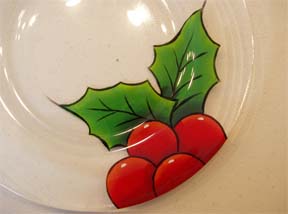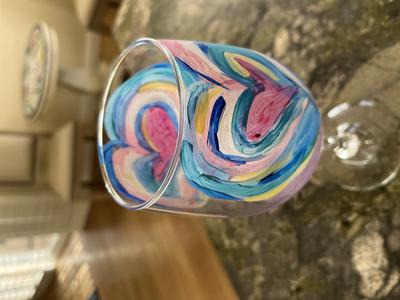REVERSE GLASS PAINTING
There’s been growing interest in the art of reverse glass painting recently. Glass painting in general has been, and will always be, popular... but what does painting in reverse mean?
When you paint with opaque paints on the underside of a clear glass surface you have to work in logical layers. The finished artwork will be viewed from the front while the artist works on the back. In this case the artist needs to begin with objects or light areas that are closest working his way back in layers to the most distant elements.
To better understand reverse glass painting here’s an example. If I were to paint a simple cherry on a checkered background on the underside of a glass trivet, I would start with a little white dot highlight and the cherry stem. Then I would fill in the cherry with red until it was opaque. And finally I would add the checkered background.
In a traditional painting, say done on a canvas, the artist works on the front and the viewer sees the work from the front. This means the artist will begin with the objects furthest away.
Let’s use the cherry example on a canvas. I’d begin with the checkered pattern first, and then paint the cherry a solid red on top and finally I’d add the stem and the little dot highlight.

It’s challenging to study an image and have to dissect it so that you can arrive at the right order in which the paints will be layered. Have a look at my simple instruction packet for painting holly leaves and berries on a clear glass plate.
Obviously, very intricate reverse glass painting items are far more complicated than this simple berry example but it should help you understand the very basic idea of this art form.
Anyway, although we have modern glass paints and techniques available to us today, the art of painting on the back of glass goes way back to the 4th century A.D. Usually tiny miniatures of religious figures and symbols. The Italians really made it popular during the Renaissance period. I’m just glad we’re still doing it today.
Something Else To Consider
If you want to work with transparent glass paints, understand that each transparent layer will affect the first layer of color. If you layer transparent red on top of yellow, you’ll end up with orange. Add transparent yellow to a blue layer and you have green. You get the idea.
You may need to isolate some elements of the design so that you don’t end up getting the transparent paints one on top of each other. Planning can be very important when considering a new design. But there’s something to be said for spontaneity too!
So don’t restrict yourself. If you want to experiment with abstract and free form work, go for it. Why not try a combination of opaque paints and transparent ones? Try different brush styles too! Just have fun with it.
If you’ve never painted on glass before, you’re going to have to practice a bit. For that reason I’ve written lots about glass painting. I think you’ll find it very helpful.
If you need help choosing the right kinds of glass paints for your project idea, you can learn a whole lot more on our Glass Paint Page.
I really hope you’ll give reverse glass painting a try. And if you have any questions don’t hesitate to contact me.
Let's leave Reverse Glass Painting and go to Glass Painting.
Return to our Decorative Painting Home Page.
You Can Paint These Trees and More
Get Your Video Course Now
Introductory Price
Save 55% plus
a Money Back Guarantee
Site Search
| site search by freefind | advanced |
You Can Paint These Trees and More
Get Your Video Course Now
Introductory Price
Save 55% plus
a Money Back Guarantee







New! Comments
Have your say about what you just read! Leave me a comment in the box below.